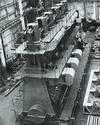 During the First World War the Clyde turned out enormous numbers of naval vessels and merchant ships, the latter to replace tonnage sunk by German submarines. The leading engine-builders at that time were the shipbuilders, Barclay, Curle & Co, the Fairfield Shipbuilding & Engineering Co, and Alexander Stephen & Co, as well as Harland & Wolff of Belfast who were setting up their diesel engine works as war broke out. There was one large engine-builder, David Rowan & Co, that made engines for shipbuilders who had no engine works.
During the First World War the Clyde turned out enormous numbers of naval vessels and merchant ships, the latter to replace tonnage sunk by German submarines. The leading engine-builders at that time were the shipbuilders, Barclay, Curle & Co, the Fairfield Shipbuilding & Engineering Co, and Alexander Stephen & Co, as well as Harland & Wolff of Belfast who were setting up their diesel engine works as war broke out. There was one large engine-builder, David Rowan & Co, that made engines for shipbuilders who had no engine works.
 Stephens, Fairfield and Rowans could all build turbines and all of these builders, as well as a number of smaller ones, made reciprocating engines. After the end of the War, a pattern of demand developed that persisted into the 1950s in which large vessels and all Royal Naval fighting ships were usually propelled by steam turbines, as were high-speed passenger ships. Medium-sized ships were either motor-ships, or fitted with steam turbines or reciprocating engines, depending on the preference of the owners. Small vessels were either motor-ships or propelled by reciprocating engines. The proportion of motor-ships increased steadily and reciprocating engines fell out of favour altogether in the early 1950s.
Stephens, Fairfield and Rowans could all build turbines and all of these builders, as well as a number of smaller ones, made reciprocating engines. After the end of the War, a pattern of demand developed that persisted into the 1950s in which large vessels and all Royal Naval fighting ships were usually propelled by steam turbines, as were high-speed passenger ships. Medium-sized ships were either motor-ships, or fitted with steam turbines or reciprocating engines, depending on the preference of the owners. Small vessels were either motor-ships or propelled by reciprocating engines. The proportion of motor-ships increased steadily and reciprocating engines fell out of favour altogether in the early 1950s.
 The marine engineering industry in Glasgow was still virtually intact in the late 1950s, but would not survive in recognisable form for much longer as patterns of demand for ships changed radically on account of such developments as bulk carriage and containerisation, which required much larger ships, and jet aircraft rapidly replacing passenger liners.
The marine engineering industry in Glasgow was still virtually intact in the late 1950s, but would not survive in recognisable form for much longer as patterns of demand for ships changed radically on account of such developments as bulk carriage and containerisation, which required much larger ships, and jet aircraft rapidly replacing passenger liners.